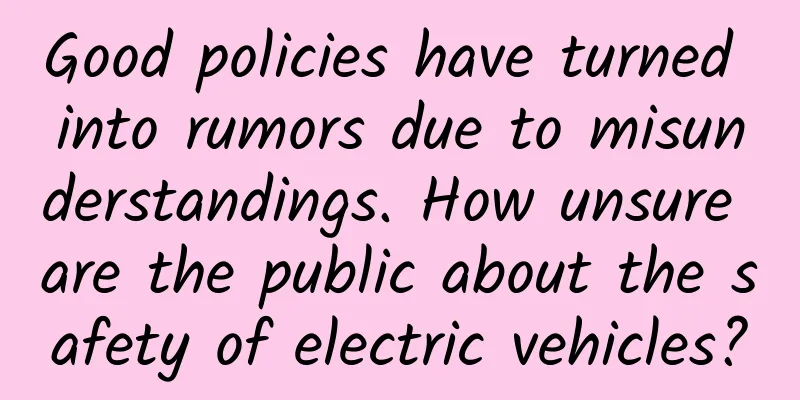Good policies have turned into rumors due to misunderstandings. How unsure are the public about the safety of electric vehicles?

|
Recently, the Ministry of Commerce and seven other departments jointly issued the "Notice on Further Improving the Work Related to Car Trade-in", increasing the previous subsidy amounts for car trade-in, from 10,000 yuan for new energy passenger cars and 7,000 yuan for fuel passenger cars to 20,000 yuan and 15,000 yuan respectively. This is nothing, and it is good news for people who are planning to change their cars. However, the "Detailed Rules for the Implementation of the Automobile Trade-in Subsidy" also stipulates that new energy passenger cars registered before April 30, 2018 can also be included in the scope of application of the old-for-new subsidy. Because there are only 6 years from 2018 to now, a stupid rumor that "the service life of new energy vehicles is only 6 years" has emerged. It is worth mentioning that as early as 2020, the relevant state departments have abolished the driving age regulations for non-commercial cars. Many people combine this fact with the view that "the service life of new energy vehicles is only 6 years". What is the truth? In fact, the Ministry of Commerce and seven other departments launched a subsidy policy for replacing old cars with new ones in order to encourage car consumption and speed up car upgrades, not to force consumers to change cars. At present, China's automobile market is gradually changing from an incremental market to a stock replacement market. To promote automobile consumption, it is necessary to promote the replacement of old stock models with new ones. This is a very common policy. The car trade-in subsidy policy takes many aspects into consideration when it is formulated, but it has no necessary connection with the "lifespan of new energy passenger vehicles". Therefore, the statement that new energy vehicles can only be used for 6 years is an outright rumor. No rumor comes out of thin air. Many rumors that are more destructive and spread more widely have a basis in reality at the beginning. The rumor that new energy vehicles only have a lifespan of 6 years is certainly a rumor, but it also has a certain basis in reality, that is, the current new energy vehicles are indeed not very reassuring for consumers. For example, every summer is the peak season for electric vehicles to spontaneously combust, and is therefore called the "spontaneous combustion season" by many people. In March 2024, Ouyang Minggao, an academician of the Chinese Academy of Sciences, pointed out at the Electric Vehicle Hundred People Forum that the spontaneous combustion rate of fuel vehicles reached 0.58 per 10,000, while the spontaneous combustion rate of new energy vehicles was only 0.44 per 10,000, so new energy vehicles are safer than fuel vehicles. This view quickly aroused strong opposition, and Ouyang Minggao himself was even caught in cyber violence. This incident also proves from one aspect that the public is not satisfied with the safety performance of electric vehicles, and the occasional spontaneous combustion accidents of electric vehicles make them feel frightened. In addition to the long-standing problem of spontaneous combustion rate, the frequent accidents of "autonomous driving" of new energy vehicles are also an important reason why consumers question the safety performance of electric vehicles. In the past two years, the competition in the field of intelligent driving in China has been very fierce. From the initial L2-level driving assistance function to the current "end-to-end" intelligent driving mode competition, the technology is constantly improving, but accidents caused by intelligent driving are also one after another. Mainstream manufacturers such as BYD, Ideal, Xiaopeng, and Tesla are all involved. Among them, the industry that has always boasted of being "far ahead in intelligent driving" and "difficult to crash into" has also encountered problems such as AEB failing to brake and crashing when reversing, and even casualties have occurred. Many mainstream new energy manufacturers claim that their smart driving can achieve "zero takeover", but in actual car use environments, they often make low-level mistakes such as not being able to distinguish between real people and billboards, being dazed at complex intersections, AEB failing to start in time, and judging small-eyed drivers as "asleep". If safety cannot be guaranteed, how can we talk about lifespan? At the same time, the service life of power batteries, which consumers have always been concerned about, has not been determined. It is generally believed that the battery life is more than 8 years, but China's new energy vehicles will not really become popular until after 2020, and the vast majority of car owners buy their cars within 4 years. Whether the performance of power batteries will decline in the future and whether the probability of fire will increase are all things that make consumers unsure. In addition, the current new energy vehicles are becoming more and more like electronic products, and the lifespan of electronic products is generally short. It is equipped with a large number of high-precision electronic components, and it is inevitable that the lifespan will decrease under high-intensity and complex environment use. The smart cockpits commonly found in electric vehicles integrate a large amount of complex software and hardware, and may in the future also encounter the problem that current Android phones "get stuck after a long time of use." If an electric car that is driving autonomously suddenly gets stuck, it could cause a serious traffic accident. There are many rumors in the market, such as "electric cars will be scrapped after 6 years", "electric cars will increase radiation", and "electric cars are more likely to be struck by lightning when driving in thunderstorms". The root cause of this phenomenon is that current electric vehicles cannot reassure consumers in terms of product performance and safety performance. In addition, the superimposed publicity such as "far ahead", "zero takeover throughout the process", and "the best within 5 million" has raised the public's unrealistic expectations, causing panic even about occasional accidents. Therefore, in order to eliminate rumors, our electric vehicle industry should first improve product quality and lower the tone of publicity, and rumors will naturally lose their living space. As a winner of Toutiao's Qingyun Plan and Baijiahao's Bai+ Plan, the 2019 Baidu Digital Author of the Year, the Baijiahao's Most Popular Author in the Technology Field, the 2019 Sogou Technology and Culture Author, and the 2021 Baijiahao Quarterly Influential Creator, he has won many awards, including the 2013 Sohu Best Industry Media Person, the 2015 China New Media Entrepreneurship Competition Beijing Third Place, the 2015 Guangmang Experience Award, the 2015 China New Media Entrepreneurship Competition Finals Third Place, and the 2018 Baidu Dynamic Annual Powerful Celebrity. |
<<: Meizu Note3 unboxing photos: MX5-inspired, quality 1,000-yuan phone
Recommend
Contribution | How to build a team operation system before the product goes online?
A friend found me through Zaixing to consult abou...
How to write a website analysis report? How to write a website diagnostic analysis report?
For website optimization SEO practitioners, after...
Baijiahao operation guide, how to operate Baijiahao?
1. Which one is better in the Baijiahao field? (F...
Google launches Android Auto Beta testing program to encourage users to try and submit feedback
Google is launching a new beta program for Androi...
Why are cerebral infarctions happening at a younger age? Reminder: Be careful when your body sends out these 8 warnings
25-year-old Arong (pseudonym) is a veteran game p...
Wake up, there is no food in the world that makes you thinner the more you eat it!
Have you heard of "negative calorie foods&qu...
Why does everyone dislike using the "smart voice" in their mobile phones?
As we all know, voice navigation, voice photograp...
How to establish a user perspective? Use the 7-step analysis method!
What is the user perspective? This is actually a ...
How can brand marketing on Children’s Day focus on “older children”?
Abstract: Children's Day is approaching. Inst...
Android Activity Security
Each Android Application is composed of basic And...
Can a crocodile wake up after being frozen into a popsicle? I advise you not to touch the frozen crocodile's nose!
Not long ago, a short video went viral. In the vi...
Childhood memories! The science version of "The Foot of Ivy"
Produced by: Science Popularization China Produce...
How much can AI help you fill in your college entrance examination application form? Just a supplement!
□ Zhang Gailun, a reporter from Science Times The...
I had a herniated lumbar disc and after doing traction, I was almost paralyzed because of this...
"Lumbar disc herniation", which used to...
Korean battery is in trouble. Can domestic battery companies take advantage of the situation to rise?
Some time ago, multiple Samsung Note7 battery exp...









